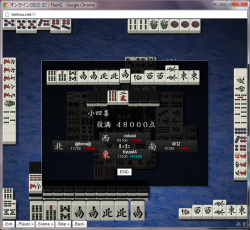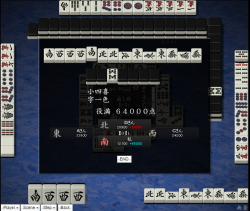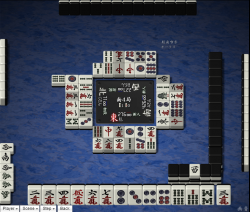Yakuman: Difference between revisions
m (Minor grammatical change) Tags: Visual edit Mobile edit Mobile web edit |
(rewrite. also, "chance only increases with # of games played" is false, because game actions can increase your chance for a yakuman (e.g. not calling kyuushu kyuuhai)) |
||
| Line 1: | Line 1: | ||
[[Image:Shosusshii.png|thumb|right|250px|[[Shousuushii]]]] | [[Image:Shosusshii.png|thumb|right|250px|[[Shousuushii]]]] | ||
'''Yakuman''' {{kana|役満}} are a class of [[yaku]] (hand patterns) | '''Yakuman''' {{kana|役満}} are a special class of [[yaku]] (hand patterns) whose [[scoring table|point value]] is set to the maximum. Traditionally, a yakuman is the most that any one hand can reach. However, some [[#Multiple yakuman|rule variations]] allow multiple yakuman to be combined. These hands are considered rare and difficult. | ||
==Definition== | |||
Yakuman are worth 8000 base points; for a non-dealer, this would equal 32000 points for ron, or 8000/16000 points from tsumo. | |||
A [[kazoe yakuman]] is scored when a hand reaches 13 or more han. Otherwise, in standard rules, a hand cannot score both yakuman and yaku at the same time. In other words, if a hand contains a yakuman pattern, it has 0 han. | |||
In [[aotenjou]], yakuman ''can'' score with other yaku. | |||
==Difficulty== | ==Difficulty== | ||
Yakuman are rare and thus difficult. Most yakuman have specific restrictions that make them difficult, such as [[ryuuiisou]] only allowing 6 of 34 tile types, or [[shousuushii]] requiring 3 [[wind]] triplets and a pair of the fourth. Others are achieved in specific, rare conditions, such as [[tenhou and chiihou]] being won on the first draw. | |||
Among the yakuman, three in particular are considered to be among the easiest to attain: [[suuankou]], [[daisangen]], and [[kokushi musou]]. Collectively, these three yakuman are known as '''yakuman gosanke''' {{kana|役満御三家}}, or "the three big families of yakuman". | |||
=== Chance === | |||
While elusive, yakuman are not impossible. Players with a chance for a yakuman can benefit from going for said yakuman. Like any other decision, this choice depends on game state, such as the current point standings, number of tile draws left, and the current hand. | |||
The more games the play, the higher the chance you'll score a yakuman eventually. Naturally, luck also players a role. When a yakuman becomes viable to aim for, a player should recognize the chance and seize it. | |||
The | |||
The chance for a yakuman is not constant; it decreases as opponents grow in skill level. Higher skill opponents tend to have better [[tile efficiency]], so they can win hands faster. Also, they are more likely to defend once a yakuman threat is present. Example statistics: | |||
*[[Tenhou.net]], tokujou room, month of Mar. 2024: ~1/930.6 of winning hands are yakuman | |||
*Tenhou.net, houou room, month of Mar. 2024: ~1/1228 of winning hands are yakuman | |||
== | === Winning with yakuman === | ||
A yakuman [[ron]] can put an opposing player in negative points, potentially ending the game. In any case, a yakuman will almost always put you in a huge lead. Still, you must not be complacent, as you still have a chance to drop down. | |||
==Multiple Yakuman== | |||
[[Image:Double yakuman ron.png|thumb|right|250px|High level player [http://tenhou.net/0/?log=2014092416gm-00a9-0000-3263f602&tw=1&ts=4 falling to double yakuman].]] | [[Image:Double yakuman ron.png|thumb|right|250px|High level player [http://tenhou.net/0/?log=2014092416gm-00a9-0000-3263f602&tw=1&ts=4 falling to double yakuman].]] | ||
[[Image:Harmless.png|thumb|right|250px|Relatively [http://tenhou.net/0/?log=2012032214gm-0009-0000-cc8c2c61&tw=3&ts=12 harmless threat].]] | [[Image:Harmless.png|thumb|right|250px|Relatively [http://tenhou.net/0/?log=2012032214gm-0009-0000-cc8c2c61&tw=3&ts=12 harmless threat].]] | ||
{{main| | {{main|Multiple yakuman}} | ||
Some yakuman may combine if their tile patterns allow them to do so. The most common combinations involve [[tsuuiisou]] along with [[shousuushii]] and [[daisangen]]. [[Tenhou and chiihou]] can combine with any yakuman except [[suukantsu]], though this event is exceptionally rare. | |||
In some rulesets, a hand can only score one yakuman, even if a hand contains multiple. Others allow the yakuman to stack, e.g. a double yakuman, worth 64000 points, for suuankou + daisangen. Sometimes, special patterns like [[suuankou tanki]] and [[daisuushi]] are worth double yakuman on their own. | |||
== Avoiding yakuman == | == Avoiding yakuman == | ||
The last thing any player should do is play into a yakuman hand. | The last thing any player should do is play into a yakuman hand. Alas, such plays do happen, even to the best of players. Of course, this is where [[defense]] is relevant, especially when a yakuman is an apparent threat. Then again, if a hand is closed, it's difficult to tell if a hand is a yakuman. | ||
==External links== | ==External links== | ||
Revision as of 22:15, 20 March 2024

Yakuman 「役満」 are a special class of yaku (hand patterns) whose point value is set to the maximum. Traditionally, a yakuman is the most that any one hand can reach. However, some rule variations allow multiple yakuman to be combined. These hands are considered rare and difficult.
Definition
Yakuman are worth 8000 base points; for a non-dealer, this would equal 32000 points for ron, or 8000/16000 points from tsumo.
A kazoe yakuman is scored when a hand reaches 13 or more han. Otherwise, in standard rules, a hand cannot score both yakuman and yaku at the same time. In other words, if a hand contains a yakuman pattern, it has 0 han.
In aotenjou, yakuman can score with other yaku.
Difficulty
Yakuman are rare and thus difficult. Most yakuman have specific restrictions that make them difficult, such as ryuuiisou only allowing 6 of 34 tile types, or shousuushii requiring 3 wind triplets and a pair of the fourth. Others are achieved in specific, rare conditions, such as tenhou and chiihou being won on the first draw.
Among the yakuman, three in particular are considered to be among the easiest to attain: suuankou, daisangen, and kokushi musou. Collectively, these three yakuman are known as yakuman gosanke 「役満御三家」, or "the three big families of yakuman".
Chance
While elusive, yakuman are not impossible. Players with a chance for a yakuman can benefit from going for said yakuman. Like any other decision, this choice depends on game state, such as the current point standings, number of tile draws left, and the current hand.
The more games the play, the higher the chance you'll score a yakuman eventually. Naturally, luck also players a role. When a yakuman becomes viable to aim for, a player should recognize the chance and seize it.
The chance for a yakuman is not constant; it decreases as opponents grow in skill level. Higher skill opponents tend to have better tile efficiency, so they can win hands faster. Also, they are more likely to defend once a yakuman threat is present. Example statistics:
- Tenhou.net, tokujou room, month of Mar. 2024: ~1/930.6 of winning hands are yakuman
- Tenhou.net, houou room, month of Mar. 2024: ~1/1228 of winning hands are yakuman
Winning with yakuman
A yakuman ron can put an opposing player in negative points, potentially ending the game. In any case, a yakuman will almost always put you in a huge lead. Still, you must not be complacent, as you still have a chance to drop down.
Multiple Yakuman


Some yakuman may combine if their tile patterns allow them to do so. The most common combinations involve tsuuiisou along with shousuushii and daisangen. Tenhou and chiihou can combine with any yakuman except suukantsu, though this event is exceptionally rare.
In some rulesets, a hand can only score one yakuman, even if a hand contains multiple. Others allow the yakuman to stack, e.g. a double yakuman, worth 64000 points, for suuankou + daisangen. Sometimes, special patterns like suuankou tanki and daisuushi are worth double yakuman on their own.
Avoiding yakuman
The last thing any player should do is play into a yakuman hand. Alas, such plays do happen, even to the best of players. Of course, this is where defense is relevant, especially when a yakuman is an apparent threat. Then again, if a hand is closed, it's difficult to tell if a hand is a yakuman.
External links
- Yakuman in Japanese Wikipedia
- Yaku frequency among Tenhou.net players (Japanese)
- Lists all the yaku occurrences in Tenhou.net by percentages and by ranked lobby.
- Lists any yakuman scored within the regular L0000 lobby, within the current month.
| |||||||||||||||||||||||||||||||
